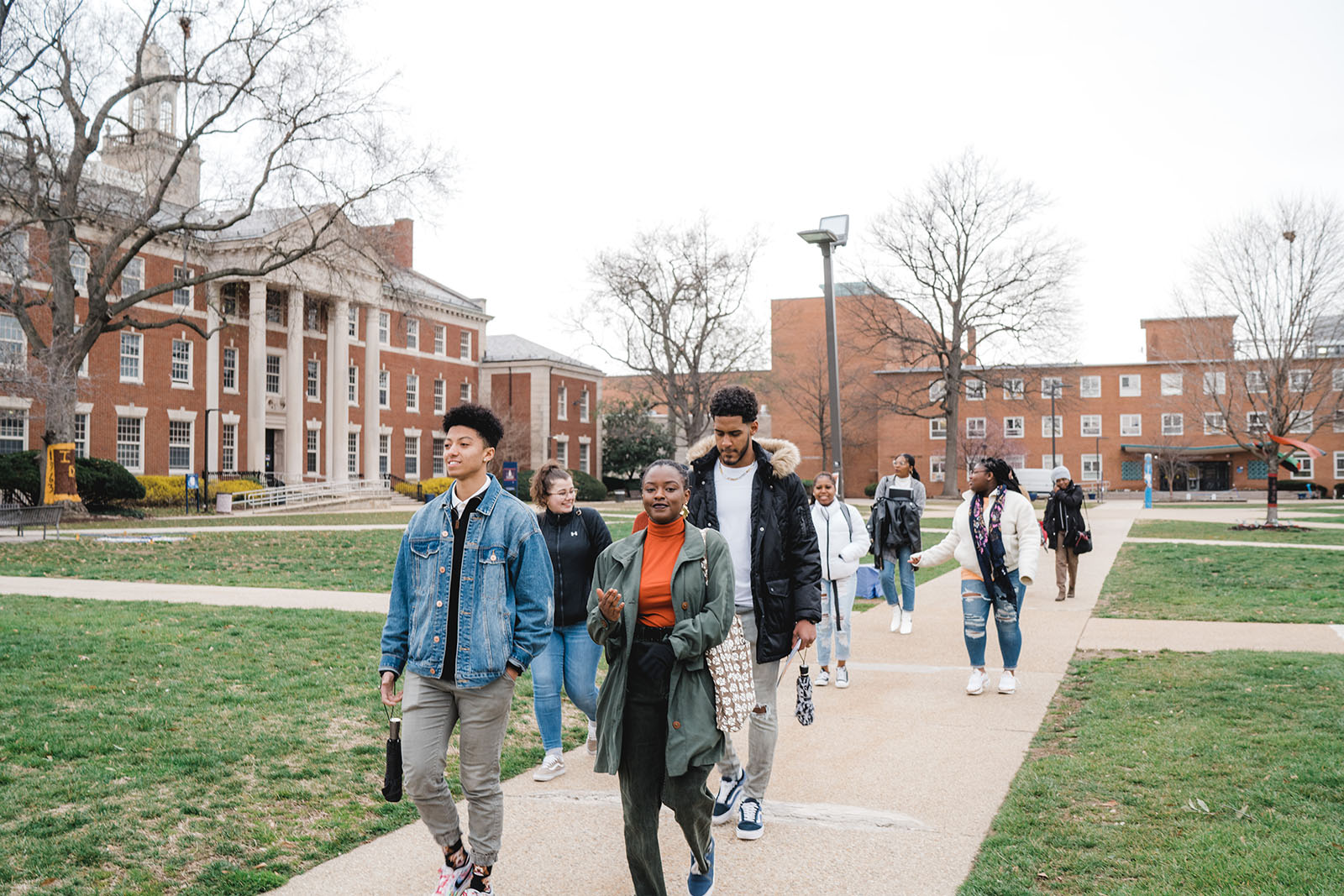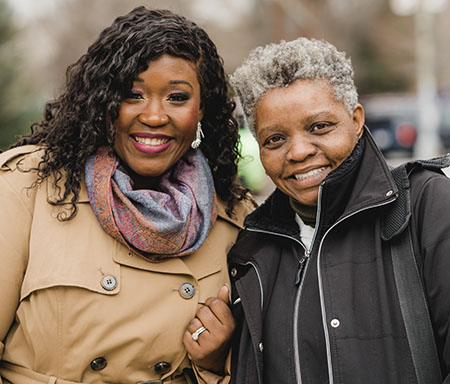Forging Cross-Campus Connections
Two sites Muhlenberg students visited on the Office of Multicultural Life’s second cultural immersion alternative spring break were the historically Black Howard and Morgan State Universities.
By Meghan Kita | Photos by Joshua Fernandez
On an overcast Friday near the middle of Howard University’s spring semester, a group of Muhlenberg students toured its Washington, D.C., campus. Howard, one of the top historically Black colleges and universities (HBCUs) in the country, was one stop on the Muhlenberg students’ cultural immersion alternative spring break tour of Baltimore, Maryland, and D.C. Accompanying them were the trip’s organizers: Robin Riley-Casey, Muhlenberg’s director of multicultural life, and Kiyaana Cox Jones, assistant director of multicultural life and a 2008 Howard graduate.
As the group explored campus, one Muhlenberg student fell into step with Cox Jones. “Is this what your whole four years was like?” the student asked her.
“I felt reluctant to be honest and say ‘yeah.’ I didn’t want them to fall in love with it,” she says. “But I understood what they were trying to say: For once, they didn’t feel like the outsider, like a person who was different.”
This was one of the primary goals of the cultural immersion spring break: to allow students of color who attend a predominantly white institution (that is, Muhlenberg) to experience HBCUs (Baltimore’s Morgan State University and Howard) and make connections with the students there. At both universities, the Muhlenberg group met with student leaders and exchanged contact information. The idea is to create a network of “social media pals,” says Cox Jones; students from all three institutions who are able to collaborate on social justice work despite being in different places.
“When a movement needs to happen, you don’t have to wait until you graduate to do it,” she says. “You can do it now, across campuses.”

Muhlenberg students explore Howard University's campus.
Crafting the Experience
This was the College’s second cultural immersion spring break; the first, to Memphis, Tennessee, took place in 2013. Riley-Casey helped organize that trip along with Roberta Meek, lecturer of media & communication and history. Students visited the Lorraine Motel, where Martin Luther King Jr. was assassinated, and the adjacent National Civil Rights Museum, as well as the first Tennessee high school to be integrated.
“The students came back more aware of their culture and the way young people changed the trajectory of people of color, particularly Black people, during that time,” Riley-Casey says.
 The idea to do another cultural immersion trip, including stops at HBCUs, was percolating in the Office of Multicultural Life before Cox Jones joined the team last fall. The starting point that was presented to her, she says, was “to give our students exposure to students on other college campuses, specifically HBCUs, so they could have discussions around the differences and the things they have in common, as well as how we might work together to build a network of students who are being progressive.”
The idea to do another cultural immersion trip, including stops at HBCUs, was percolating in the Office of Multicultural Life before Cox Jones joined the team last fall. The starting point that was presented to her, she says, was “to give our students exposure to students on other college campuses, specifically HBCUs, so they could have discussions around the differences and the things they have in common, as well as how we might work together to build a network of students who are being progressive.”
She and Riley-Casey (pictured) worked together to craft an itinerary, one that would include Cox Jones’ alma mater as well as Morgan State. They added stops at the National Great Blacks In Wax Museum in Baltimore and the National Museum of African American History and Culture in D.C. Rounding out the trip was a day of community engagement with the nonprofit organization So Others Might Eat in D.C.
“No matter where we go, it’s important that there’s a service component,” says Cox Jones. (The 2013 group worked in a center for the families of AIDS victims.) “That’s what our ancestors did. We must continue the legacy of service. It’s a link in regards to who we are.”
Peers Leading Peers
To prepare for the trip, the group of 11 selected students (there was also a waiting list) met with Riley-Casey and Cox Jones three times. The idea was to discuss the itinerary, learn about the stops and get to know each other before spending four days in a van and an Airbnb together.
Two students, Krystal Hall ’21 and Kelsey Casimir ’23, applied and were selected to be site leaders. The stops on the itinerary were split between them, and they each researched and led their peers through those sites and their discussions afterward. For Casimir, that meant preparing a scavenger hunt for the National Museum of African American History and Culture to keep students engaged.
“The students put a lot of work into this,” Cox Jones says. “They didn’t walk into any space not knowing what was going on.”
That preparation made for productive conversations with the students they met at the HBCUs, many of whom were in leadership positions on their campuses. For example, Hall, who’s a resident advisor (RA) at Muhlenberg, learned that the tour guide at Howard was also an RA and had a discussion about what that meant on each campus.
“I realized how similar we are,” Hall says. “Coming into this trip, I had never been on an HBCU campus. It was nice to experience that and see it. It made me think about the way I looked at a PWI campus: how our voices, especially as students of color, can have an impact on this campus and how we are really leaders.”
The feedback from the students at Morgan State and Howard was equally powerful. “They recognize that some of the social justice work the students are doing at Muhlenberg is very different from the work they’re doing at the HBCUs,” Riley-Casey says. “There, they see themselves as leaders. They engage with their faculty, staff and administrators in a very clear way. They recognize that the students at Muhlenberg are fighting a different kind of struggle just to be seen. They value that, because that’s not a fight they have at an HBCU.”

Cox Jones speaks during an info session at Howard University.
Looking Ahead
The Muhlenberg group’s recap meeting after the trip was canceled as students left campus in the wake of COVID-19, but its network of social media pals can continue to build online despite closures (Howard and Morgan State are also conducting classes remotely for the remainder of the semester).
The Muhlenberg students left the trip inspired to grow in their leadership roles at the College. Casimir is interested in getting involved in the Student Government Association and/or as part of a group’s executive board. Hall is imagining new programming surrounding equity and inclusion that she can introduce to her floor in East Hall next year.
“The experience changed my perspective on being a student of color, as an RA, as a leader, and it made me more enthusiastic to come back on campus and to be an advocate for change and diversity,” she says.
Cox Jones says she was already thinking about what the next cultural immersion spring break might look like while students were on this one. The itinerary would certainly be different than either of the previous trips, she says, but the goals would be similar: “There are so many other ways to continue this experience of honoring the ancestors before us and learning all we can about who we are so we can be our most authentic selves even in spaces where we are not the majority.”
.jpg)
Muhlenberg students and staff join Howard student guides in a group photo
